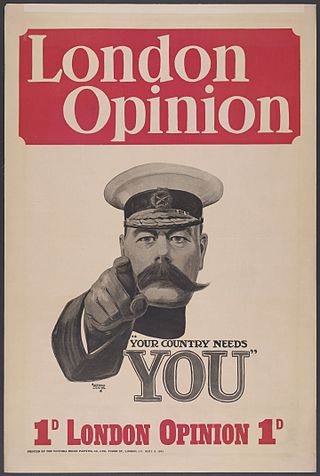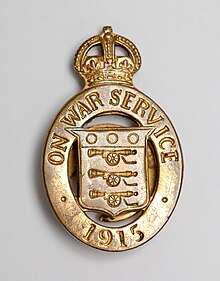Reserved occupations in the UK in World War II
In 1938, a Schedule of Reserved Occupations was created with the goal of exempting skilled workers from being conscripted into service. This idea was drawn up because of lessons learned during World War I when many skilled labourers were drawn into service, which created problems where positions needed filling. Examples of reserved occupations in the Second World War included coal mining, ship building, railway and dockworkers, farmers, teachers, doctors and lighthouse keepers. [2] Not all of these fields were immediately exempt from duty. For example, a lighthouse keeper was exempt from being conscripted from the age of 18, whilst a trade union official was not exempt until he reached 30. Married men in these occupations also had lower exemption ages. The engineering sector had the most reserved occupations. [2]
The idea was constantly reviewed throughout the war, as women, again, began to work more in industries such as munitions. This meant that men were free to join other organisations such as the Special Constabulary, the Home Guard or the ARP. It also allowed for men to join up and give them responsibilities towards the war effort, as well as allowing for them to be less stressed about not being able to directly be involved in the action. Also, many pacifists and conscientious objectors worked in reserved occupations as a compromise or to avoid call-up. Harper Adams Agricultural College saw a huge demand for places during the Second World War, as both agricultural students and farmers were exempt from conscription, as were students.
In the UK, coal mining was not a reserved occupation at the start of the war, and there was a great shortage of coal miners. Consequently, starting in December 1943, one in ten men conscripted was chosen at random to work in the mines. These men became known as "Bevin Boys" after the creator of the scheme, Ernest Bevin, the Minister of Labour and National Service.
A schedule of Reserved Occupations also existed in Canada during World War II.

Conscription is the state-mandated enlistment of people in a national service, mainly a military service. Conscription dates back to antiquity and it continues in some countries to the present day under various names. The modern system of near-universal national conscription for young men dates to the French Revolution in the 1790s, where it became the basis of a very large and powerful military. Most European nations later copied the system in peacetime, so that men at a certain age would serve 1–8 years on active duty and then transfer to the reserve force.

A conscientious objector is an "individual who has claimed the right to refuse to perform military service" on the grounds of freedom of thought, conscience, or religion. The term has also been extended to objecting to working for the military–industrial complex due to a crisis of conscience. In some countries, conscientious objectors are assigned to an alternative civilian service as a substitute for conscription or military service.

At the beginning of 1914 the British Army had a reported strength of 710,000 men including reserves, of which around 80,000 were professional soldiers ready for war. By the end of the First World War almost 25 percent of the total male population of the United Kingdom of Great Britain and Ireland had joined up, over five million men. Of these, 2.67 million joined as volunteers and 2.77 million as conscripts. Monthly recruiting rates for the army varied dramatically.

The Selective Service System (SSS) is an independent agency of the United States government that maintains information on U.S. citizens and other U.S. residents potentially subject to military conscription and carries out contingency planning and preparations for two types of draft: a general draft based on registration lists of men aged 18–25, and a special-skills draft based on professional licensing lists of workers in specified health care occupations. In the event of either type of draft, the Selective Service System would send out induction notices, adjudicate claims for deferments or exemptions, and assign draftees classified as conscientious objectors to alternative service work. All male U.S. citizens and immigrant non-citizens who are between the ages of 18 and 25 are required by law to have registered within 30 days of their 18th birthdays, and must notify the Selective Service within ten days of any changes to any of the information they provided on their registration cards, such as a change of address. The Selective Service System is a contingency mechanism for the possibility that conscription becomes necessary.

Bevin Boys were young British men conscripted to work in coal mines between December 1943 and March 1948, to increase the rate of coal production, which had declined through the early years of World War II. The programme was named after Ernest Bevin, the Labour Party politician who was Minister of Labour and National Service in the wartime coalition government.

Military service is service by an individual or group in an army or other militia, air forces, and naval forces, whether as a chosen job (volunteer) or as a result of an involuntary draft (conscription).

In the United States, military conscription, commonly known as the draft, has been employed by the U.S. federal government in six conflicts: the American Revolutionary War, the American Civil War, World War I, World War II, the Korean War, and the Vietnam War. The fourth incarnation of the draft came into being in 1940, through the Selective Training and Service Act; this was the country's first peacetime draft. From 1940 until 1973, during both peacetime and periods of conflict, men were drafted to fill vacancies in the U.S. Armed Forces that could not be filled through voluntary means. Active conscription in the United States ended in 1973, when the U.S. Armed Forces moved to an all-volunteer military. However, conscription remains in place on a contingency basis; all male U.S. citizens, regardless of where they live, and male immigrants, whether documented or undocumented, residing within the United States, who are 18 through 25 are required to register with the Selective Service System. United States federal law also continues to provide for the compulsory conscription of men between the ages of 17 and 44 who are, or who have made a declaration of intention to become, U.S. citizens, and additionally certain women, for militia service pursuant to Article I, Section 8 of the United States Constitution and 10 U.S. Code § 246.

The Confederate States Congress was both the provisional and permanent legislative assembly of the Confederate States of America that existed from 1861 to 1865. Its actions were for the most part concerned with measures to establish a new national government for the Southern proto-state, and to prosecute a war that had to be sustained throughout the existence of the Confederacy. At first, it met as a provisional congress both in Montgomery, Alabama, and Richmond, Virginia. As was the case for the provisional Congress after it moved to Richmond, the permanent Congress met in the existing Virginia State Capitol, a building which it shared with the secessionist Virginia General Assembly.

Compulsory military training (CMT), a form of conscription, was practised for males in New Zealand between 1909 and 1972. Military training in New Zealand has been voluntary before then and ever since.

A reservist is a person who is a member of a military reserve force. They are otherwise civilians, and in peacetime have careers outside the military. Reservists usually go for training on an annual basis to refresh their skills. This person is usually a former active-duty member of the armed forces, and they remain a reservist either voluntarily, or by obligation. In some countries such as Israel, Norway, Finland, Singapore, and Switzerland, reservists are conscripted soldiers who are called up for training and service when necessary.

Since the Israeli Declaration of Independence in 1948, fixed-term military service has been compulsory in Israel. The draft laws of the Israel Defense Forces only apply to citizens who are Israeli Jews, Druze, and Circassians. As the Druze and Circassian communities are less populous, their women are exempted from the draft laws altogether. Women from the Jewish majority are not exempted from the draft laws, but serve for slightly shorter terms than their male counterparts. Israel does not conscript non-Druze Arab citizens of Israel, though their men and women may enlist voluntarily.

Conscription in Russia is a 12-month draft, which is mandatory for all male citizens who are between 18 and 30 years old, with a number of exceptions. Avoiding the draft is a felony under Russian criminal code and is punishable by up to 18 months of imprisonment. Conscripts are generally prohibited from being deployed abroad.

In the United Kingdom, military conscription has existed for two periods in modern times. The first was from 1916 to 1920, and the second from 1939 to 1960. The last conscripted soldiers left the service in 1963.

The Military Service Act 1916 was an Act passed by the Parliament of the United Kingdom during the First World War to impose conscription in Great Britain, but not in Ireland or any other country around the world.

The Military Service Act, 1917 was an Act passed by the Parliament of Canada which introduced conscription in the midst of the First World War. It was passed due to a shortage of volunteers and was an effort to recruit more soldiers.

The National Resources Mobilization Act, 1940 was a statute of the Parliament of Canada passed to provide for better planning of a much greater Canadian war effort, both overseas and in military production at home.

The "Twenty Negro Law", also known as the "Twenty Slave Law" and the "Twenty Nigger Law", was a piece of legislation enacted by the Confederate Congress during the American Civil War. The law specifically exempted from Confederate military service one white man for every twenty slaves owned on a Confederate plantation, or for two or more plantations within five miles of each other that collectively had twenty or more slaves. Passed as part of the Second Conscription Act in 1862, the law was a reaction to United States President Abraham Lincoln's preliminary Emancipation Proclamation, which was issued barely three weeks earlier. The law addressed Confederate fears of a slave rebellion due to so many white men being absent from home, as they were fighting in the Confederate Army. The Confederacy enacted the first conscription laws in United States history, and the percentage of Confederate soldiers who were conscripts was nearly double that of Union soldiers.

Conscription, sometimes called "the draft", is the compulsory enlistment of people in a national service, most often a military service. Men have been subjected to military drafts in most cases. Currently only two countries conscript women and men on the same formal conditions: Norway and Sweden.

Conscription in North Korea occurs despite ambiguity concerning its legal status. Men are universally conscripted while women undergo selective conscription. Conscription takes place at age 17 and service ends at 30. Children of the political elites are exempt from conscription, as are people with bad songbun. Recruitment is done on the basis of annual targets drawn up by the Central Military Commission of the Workers' Party of Korea and implemented locally by schools. Conscription first began before the Korean War.

The Confederate Conscription Acts, 1862 to 1864, were a series of measures taken by the Confederate government to procure the manpower needed to fight the American Civil War.











